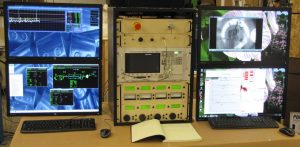Ion Beam Analysis (IBA) is a broad term for a large set of techniques that simultaneously utilize ion beams to analyze materials. These techniques are used for applications throughout many different areas of study such as materials, art and archaeology, geophysics, biology, and many more.
NEC provides systems that are capable of performing IBA techniques, including:
NEC’s complete IBA systems provide a fast, complete, and verified materials analysis answer to unknown targets.
Pictured from left to right: RF charge exchange light-ion ion source; Pelletron accelerator; control system; analysis endstation
The typical NEC IBA accelerator is based on a 1MV to 2MV S-series tandem Pelletron with a negative light-ion ion source such as our RF charge exchange source and a high energy beamline that includes our IBA analysis endstation.
 The system is computer controlled with all of the parameters needed for routine operation of the system available at a single control console. The control console includes control for the accelerator via NEC’s AccelNET software and control of the analysis endstation via NEC’s RC43 Analytical Data Collection software.
The system is computer controlled with all of the parameters needed for routine operation of the system available at a single control console. The control console includes control for the accelerator via NEC’s AccelNET software and control of the analysis endstation via NEC’s RC43 Analytical Data Collection software.
The RC43 Analytical Data Collection software collects data from several detectors simultaneously, capturing RBS, ERD, PIXE, and NRA readings. The data is computer analyzed to yield complete real-time materials analysis of a sample. To assist with crystalline or elemental mapping analysis, the software can create plots of crystal structure channeling and elemental concentrations.
The analytical software communicates with the accelerator control system receiving information and sending instructions to produce the optimal beam conditions during real time runs. The software automatically saves the data it collects where it is ready to be utilized in quantitative analysis programs such as RUMP, GUPIX, and others.